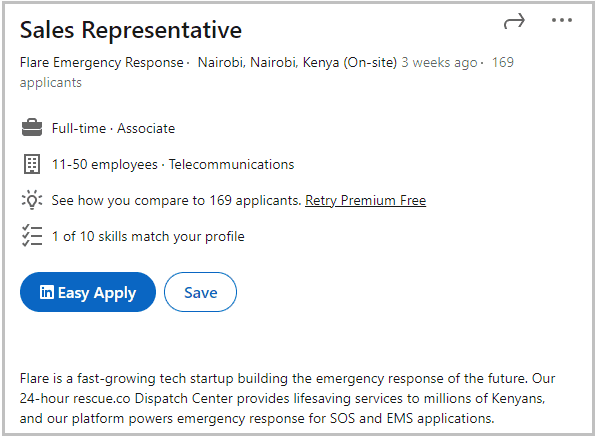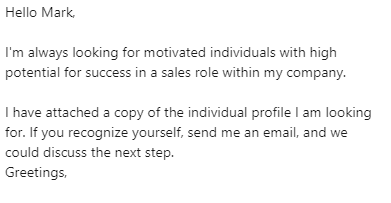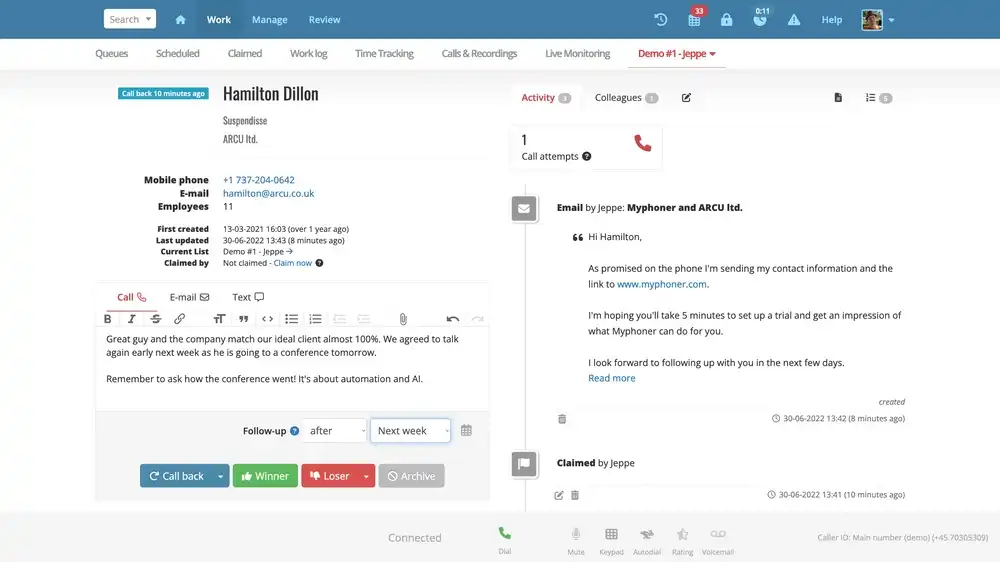How to hire your next award-winning sales officer

- November 24, 2022
Hiring a sales representative is as easy as cooking a batch of chocolate chip cookies.
You just need to post a job ad on your company’s career page or a job board for sales reps like salesheads.com.
Even better, you can hire a recruiting firm to do the heavy lifting as you focus on getting more prospects on your list.
Unfortunately, your chances of getting your next award-winning sales officer are doomed if that’s the process you plan to take.
This is what we’ll discuss in this guide. Stay tuned to get insights on the right way to hire a professional sales officer for your organization.
Why Hiring The Right Sales Officer Matters
Sales is the lifeblood of any business. Therefore, hiring a sales officer is like putting your business's survival in someone else’s hands.
As a hiring manager, you shouldn’t just look for someone who can demonstrate enthusiasm and confidence during the interview.
Those are positive attributes, but most sales reps dwindle when they enter the field.
To avoid such a scenario, differentiate candidates selling themselves in the interview and candidates genuinely ready for the job.
Getting it wrong at the hiring stage has two consequences:
- You might miss hitting your revenue goals if the sales officer doesn’t close sales as expected.
- You’ll incur more turnover costs as you’ll still have to return to the hiring process to get the right person.
According to Mike Esterday, the CEO of Integrity Solutions, “it will cost a company about 1.5 times the exiting employee’s annual salary to hire a replacement. But when it comes to salespeople, the true cost is usually much higher.”
Research also shows that US firms spend $15 billion annually to train new salespeople and another $800 million on incentives.
With all these, it’s not just okay to hire someone based on their number of connections on LinkedIn or a stellar performance in the interview.
Look for someone who can quickly jump into your vision, understand your product, and find pleasure in selling it using the skills they have acquired in the field over time.
Let’s check a few things you should keep top of mind when searching for your next award-winning sales rep.
1. Identify When To Hire
As said earlier, hiring a sales is a considerable investment.
For example, let’s assume it costs you around $100k to employ a new sales rep to your team. If your company churns five sales reps every year, that’s a whooping half million dollars that go down the drain.
So it doesn’t make sense to hire sales reps now and then. However, the unfortunate thing is that more sales reps always have the plan to look for new jobs in the next year.
This creates a battle for companies as they have to do everything to retain their best-performing sales reps.
With all the financial factors attributed to hiring a sales rep, you can only do so in a few instances. When:
- You’re short of sales reps, and there’s a proven opportunity to hit revenue goals if you bring more reps on board.
- Have a great demand for your product and your team is short-staffed.
- Want to improve your company's sales cycle.
- You have many inbound leads that your current team can’t handle.
2. Figure out the best place to get talented sales reps
Professional social media channels like LinkedIn have made getting expert sales reps easier than ever before.
The social media channel has over 800 million professionals all over the world. The keyword “sales representative” in the US alone pulls out 4.8 million people.

The platform holds a robust database of talented sales reps who will be more than ready to get started on another adventure with your company.
There are two ways to get talented sales reps on your team using LinkedIn. The easiest option is to post a job ad on LinkedIn and wait for candidates to apply for your job.
Here’s an example job ad posted on LinkedIn.

The process is simple, fast, and reliable as you quickly get candidates who you can vet on the go and filter successful applicants for person-to-person interviews.
The only disadvantage is that you’ll have to sift through many applicants to get a successful candidate.
The other option is to contact sales representatives directly on LinkedIn through a connection request and cold message.
Typically, the process involves scanning through LinkedIn to get talented sales reps who’ve been active on the platform. You then reach out to them with your job request.
You’d want to make the message short and to the point, with a strong CTA to encourage feedback. Here’s an example.

This method is very effective as you can only reach out to candidates you’re sure can resonate with your goals.
3. Match Job Profile With Candidate’s Skill and Experience
Once you’ve got a few candidates on your list, the next step is to create a job profile that targets your ideal sales rep for the job.
The job profile should be more detailed than a job description. It outlines how the salesperson will actually work once they’re employed.
For example, it can show if the sales rep will sell a $6000 product/service, if the process involves calling C-suite or somebody else, or if they’ll be upselling existing customers or hunting for new business.
Once you’ve created the job profile, the next step is matching the profile with each candidate's skills and experience.
You’re looking for someone with skills such as communication, social selling, active listening, presentation, judgment, collaboration, e.t.c.
Matching these two helps you identify the right sales rep that aligns with your company goals. For example, you’re better off hiring a sales rep who’s perfect in upselling skills to target existing customers than hiring the same salesperson to get new business.
4. Use an Interview Framework that Fits You
The interview stage is the part where you get to know the candidates personally.
Therefore, you want to maximize the process to avoid hiring the wrong person. Suppose you’re working in a massive company with an office environment. In that case, you can do a group interview where you’ve invited your company’s sales managers and leaders to aid in the vetting process.
But if you’re a start-up and need experienced salespeople, interview them in pairs. Since you won’t include your management team in the interview, get a few questions from them beforehand to ask the interviewees.
Try to make the interview as conversational as possible. The goal is to help the candidates feel calm when answering questions.
Plus, it makes the candidates feel less defensive and creates a natural environment that isn’t forced.
However, you still want to take control of the interview. Salespeople often become “talkative,” which might derail the interview's outcome.
To avoid that, inform them how long the interview will take and the response time to each question, and use directives for open-ended questions.
5. Involve your Sales Team
If you’re an established business with a huge sales team, it’s essential to involve them in the hiring process.
This doesn’t imply you should include them in the interviewing process from start to finish. Ask them for their opinion on a candidate and if they’ll be able to blend in with the team goes a long way.
The candidate will feel included in the team because they’ll interact with everyone and know how your sales process works. On the other hand, your team will feel included in making decisions about their performance.
Challenges when Hiring The Right Salesperson
As noted earlier, hiring the right salesperson isn’t an easy feat. The main challenge is, of course, the hiring cost.
But you must also be aware of these challenges to avoid wasting more time.
- Personal experience: Most hiring managers aren’t sales professionals themselves. As a result, they often don’t know what to look for when hiring a sale rep. That’s why it’s essential to involve your sales management team.
- Huge expectations: Getting an award-winning sales officer doesn’t mean your company will hit your yearly goals in the first quarter. Ground your goals in reality to avoid tension and pressure during the interview.
- Misalignment with your company culture:The best salesperson isn’t still a good fit if they can’t be an excellent addition to your company culture. Most companies end up with salespeople who don’t align with their goals, overall mindset, and dynamic. That’s something you should check out for.
Conclusion
So here’s a quick recap on what you should do when hiring your next sales officer.
- Identify When To Hire
- Figure out the best place to get talented sales reps
- Match Job Profile With Candidate’s Skill and Experience
- Use an Interview Framework that Fits You
- Involve your Sales Team
Try out these tips and see how your hiring process becomes easier with high success rates.
Supercharge the effectiveness of your sales hires


Written by
Jeppe Liisberg
Jeppe Liisberg is a forward-thinking entrepreneur and software developer who has built and contributed to multiple successful startups. With a philosophy centered on creating focused, specialized solutions that excel at solving specific challenges, Jeppe founded Myphoner after identifying a critical gap in the market for effective cold calling software.
"I believe that exceptional software should solve one core problem extraordinarily well rather than attempting to be everything for everyone," says Jeppe. "After years in the trenches as an entrepreneur, I couldn't find a cold calling solution that truly met the needs of small businesses and sales teams—so I built Myphoner to fill that void."
Today, Jeppe remains personally invested in Myphoner's success and customer satisfaction, personally welcoming new users and actively responding to feedback. This hands-on approach ensures that Myphoner continues to evolve based on real user needs while maintaining its commitment to simplicity, effectiveness, and affordability.
Connect with Jeppe on LinkedIn or reach out directly at jeppe@myphoner.com.
Related articles

Industry Related
Cold-Calling Questions to Ask to Boost Conversions
Up your cold calling game with these 14 questions that will help your leads engage with you & your offering
September 3, 2022

Industry Related
8 Techniques On How To Better Handle Your Next Inbound Sales Calls
We take you through different ways to handle inbound sales calls effectively, giving you further confidence to close the deal.
August 18, 2022

Industry Related
Build a better SaaS business with cold calling
Cold calling provides a great opportunity for SaaS businesses to get product market fit & grow their client base.
August 9, 2022